
The Next Generation, Deep Space Nine, and (depending on who you talk to) Voyager are widely regarded as the "Golden Age" of Star Trek. Since many Trekkies look back at this time period of the late 80's and 90's with the rose-tinted glasses of nostalgia, it might surprise you to read that Deep Space Nine used to be a highly divisive topic among Star Trek fans. Even to this day, I've talked to "hardcore" Trek purists who dislike Deep Space Nine because of how dark and conflict-driven the series is. I can't imagine what these people must think of the Kelvin-verse reboots, Star Trek: Discovery, or Picard. If you think I'm hard on those recent iterations of Star Trek, then you should talk to these people!
In any case, the idea that DS9 is too dark and conflict-driven is a valid criticism from someone coming from the perspective of a fan of The Original Series and Next Generation. Both of those shows were about an idealistic future in which humanity had grown out of its petty squabbles and now seeks to better itself through cooperative exploration and colonization of space. Deep Space Nine didn't quite accept those ideas at face-value. Deep Space Nine's more pragmatic approach had some fans believing that Deep Space Nine violated the spirit of Star Trek.
Many fans of The Original Series and Next Generation criticized Deep Space 9 for being "too dark".
Deep Space Nine was also the first Trek series to be highly serialized, having a singular, overarching plot throughout most of the series, and with frequent mini-arcs running for half a season or a whole season. TNG had its share of recurrent story arcs. Q's "trial of humanity" was pitched as a framing mechanism for the entire show, but ended up only serving to bookend the series, while relegating most of Q's appearances each season as comic tangents. There were other recurrent sub-plots as well, such as Worf's discommendation from the Klingon Empire and his conflict with the Duras House in the "Sins of the Father" arc, the Borg story thread, Data's relationship with his brother Lore, Wesley's training as a Starfleet officer, and a few others. But TNG stayed mostly episodic. Almost all the single episodes of TNG (and the two-parters as a whole) can be enjoyed independently, without having seen any previous episodes of TNG. That was not the case with DS9.
I missed many episodes of DS9 because
it aired on weekend evenings.
DS9 was on the air throughout my elementary school and middle school years (I was seven when the show premiered). It frequently aired (syndicated on Fox in my region) on weekend evenings, and I was often outside playing tag, riding bikes, or playing touch football or street basketball with neighbor kids. As such, I missed a lot of episodes. Due to the highly-serialized nature of the show, when I would see an episode, I would have no idea what was going on! Because I rarely watched the show, and didn't understand it when I did see it, I didn't particularly like it. I'd still watch it, because it was still Star Trek. In fact, Voyager was the first Star Trek series that I watched regularly (it being on Wednesday nights, when I wasn't outside playing), and, well, you all know how I feel about Voyager.
In fact, I grew up with a bit of a preconceived notion that Deep Space Nine was the "bad" Star Trek series -- even though critics at the time largely appreciated it. On the off chance that I could talk about Star Trek with a peer, they generally didn't like DS9 either -- for many of the same reasons.
It wasn't until my college years, when the show was released for sale on DVD that I sat down and watched the whole series from start to finish. At first, I wasn't even sure if I wanted to bother buying the DVDs. After all, DS9 was "the bad Star Trek". So why spend the money? And those DVDs cost a lot of money! CBS wanted something like $120 for a single season, compared to $30 or $40 a season for shows like E.R. or Grey's Anatomy. At least the Next Gen DVDs came in fancy, sturdy boxes. The DS9 DVDs came in cheap, flimsy, rigid plastic booklets that start to fall apart as soon as you open them. I think my mom bought them from Costco for $90 a pop -- a considerable discount, but still obnoxiously expensive!
CBS wanted $120 per season for DS9 DVDs!
I was now older. I was coming to terms with my personal identity as a progressive secular humanist. Most importantly, I could finally follow along with the various multi-episode story threads and the complex, nuanced characterizations. And boy, did my opinions on the series change!
I'll always have a soft spot for Next Generation. That show has my favorite Trek character: Data. And Picard is probably my third favorite character after Spock. After my single favorite episode of Trek, the Original Series' "Balance of Terror", most of my runner-up favorite episodes are TNG episodes. Episodes like "The Measure of a Man", "Who Watches the Watchers", "The Offspring", "The Best of Both Worlds", "Deja Q", "I, Borg", "Tapestry", "The Inner Light", "Darmok", "All Good Things...", and so on...
Despite my fondness for Next Generation, I actually think that Deep Space Nine is the better all-around show.
Every Trek series since the original has taken a couple years to really find its footing. TNG doesn't really figure itself out until midway through season 2, and Voyager takes until the 4th season to figure itself out -- if ever. I don't know if Discovery ever righted its ship, since I didn't bother to watch past the first season, and Picard didn't even become watchable until the third season. I feel like DS9 finds its footing much earlier than TNG or Voyager. Deep Space Nine's characters, themes, and stories start to fall in place by the end of season 1. In fact, one of my favorite episodes of the entire series (and one of my favorite episodes of Trek in general) is a season 1 episode: "Duet". DS9 is the only Trek series (since the original) for which one of my favorite episodes comes as early as the first season.
 - DS9 "Duet", season 1, episode 19
- DS9 "Duet", season 1, episode 19
One of my favorite DS9 episodes (and Trek episodes in general) is the season 1 Holocaust allegory, "Duet".
The last episode of season 1, "In the Hands of the Prophets" starts to set up the season-long arcs (and a series-long arc) that would become a trademark of the series. That episode introduces us to recurring villain Vedek Winn and starts the process of her gradual accumulation of power, which we'll talk about later.
But despite the series coming together better in the first season, critics of Deep Space Nine aren't wrong when they say that it "feels different" from the Original Series or Next Generation. The show is unarguably darker and more conflict-driven. The entire second half of the series is about an interstellar war, and the seasons leading up to that repeatedly tell stories about domestic terrorism, Holocaust allegories, religious persecution, and cynical politics. These sorts of themes were present in episodes of TOS and TNG here and there, but DS9, at a fundamental level, was about these difficult topics.
[More]
79b833d8-97bd-4e2f-b45e-9f666db1588a|1|5.0
Tags:Star Trek, Star Trek: Deep Space Nine, Gene Roddenberry, Federation, Starfleet, culture, ideals, cooperation, socialism, post-scarcity economics, alien, multi-culturalism, progressivism, humanism, secularism, terrorism, war, Benjamin Sisko, Kasidy Yates, Odo, Quark, Ferengi, Klingon, Cardassian, Dominion, Bajor
Firaxis will be releasing Civilization VI DLC packs with new game modes, new civilizations, and new leaders through March of 2021. Two new civilizations were released at the end of September. One of which is entirely new to the Civilization franchise. That new civ is Gaul, which is lead by Ambiorix.

For future releases that include multiple leaders or civilizations, I may put up polls on Patreon to let my Patrons decide which civ or leader to cover first (if Firaxis gives enough advance notice). I may also put up polls asking if my Patrons would prefer that I make guides focused on the new game modes. So if you would like to vote on which content you would prefer to see sooner, I hope you'll consider supporting the creation of this content on Patreon.
Gaul (or Gallia in its original Latin) is the name the Romans gave to a region of Western Europe that now encompasses France, Belgium, Netherlands, and parts of Germany and Austria. The land was inhabited by industrious Celtic tribes that frequently raided Greek and Phoenician settlements in southern Europe. Around 1200 BC, the small settlement of Hallstatt (near modern Salzburg, Austria) built an economy around salt mining and developed advanced metal-working techniques. These techniques spread throughout the tribes of Gaul until Hallstatt was abandoned for unknown reasons around 500 BC.

Ambiorix (whose name possibly translates to "protector-king") was a king of the Eburones clan in Belgian Gaul. After a drought destroyed much of the Roman harvests in Gaul, Julius Caesar requested that the Eburones give up their grain harvests to feed occupying Roman troops. Ambiorix conceeded, but he and his men soon joined the resistance against Caesar. The resistance did not last long, as the insult caused Rome to lead a genocidal campaign to exterminate the rest of the Eburones.
Overall, the Gauls held off the might of the Roman Republic until Gaul was finally subdued by Julius Caesar, who contracted tribes of Gauls to help him in his fight against the other tribes. The conquest of Gaul spring-boarded Caesar towards his destiny. Though the "Barbarians at the gates" theory is a widely-known explanation for the fall of Roman Empire, there is also the competing (or complimentary) theory of "Barbarians inside the gates". As Rome's conquests expanded across Europe and North Africa, the growing empire needed more and more soldiers to defend its borders. As such, later emperors opened military service to non-Romans, including Gallic mercenaries. These troops retained much of their Celtic culture, spoke Romanticized Gallic instead of Latin, had never been to Italy, and so had little loyalty to Roman law or culture. They fought for whoever would pay for their services, and their loyalty to their commanding officers enabled internal conflict that contributed to Rome's downfall as much (or perhaps more) than external threats.
When Belgium became an independent nation in 1830, historians found Caesar's accounts of Ambiorix (who Caesar praised as the "bravest and strongest of the Gauls"), and the government annointed him as a national hero. Poems and statues were commemorated in Ambiorix's honor throughout Belgium. Today, he is also a pop hero, appearing in Belgian cartoons and comic books.
DISCLAIMER:
Civilization VI is still a "living game". Strategies for the game (and for specific leaders and civs) may change as Firaxis applies balance patches, introduces new features, or expands the game through further DLC or expansion packs, or as the Civ community discovers new strategies or exploits. As such, the following strategy guide may change from time to time. I will try to keep it up-to-date, and will make notations whenever changes are made. I'll also post links in the official 2K forums and CivFanatics, where I'll also report any changes made. If possible and practical, I will try to retain the original content of the strategy for posterity.
I welcome any feedback or suggestions that readers wish to offer. Feel free to post on the linked forums, or by posting a comment at the bottom of the page.
This guide is up to date as of the release of the "New Frontiers" October 2020 ("Pirates") Update (ver. 1.0.6.9)
In Civilization VI, Ambiorix spreads his cities out a bit more, fueling his economy and culture with mines. He also swarms his opponents with units that support each other and promote the cultural development of the civilization.
[More]
6344ece6-72a6-4b15-a745-1a72ad1bb754|1|5.0
Tags:Sid Meier's Civilization, Civilization VI, Gaul, Ambiorix, king of the Eburones, Hallstatt culture, oppidum, gaesatae, scourge of Rome, industrial zone, production, quarry, mine, culture
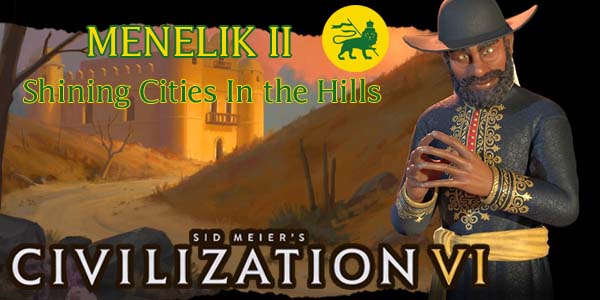
Firaxis recently released the second civilization and leader pack for its New Frontiers DLC Pass. This pack includes alternate versions of the leaders Teddy Roosevelt and Catherine de Medicci, and the new Secret Societies game mode. The main part of the new DLC, however, is the new civilization, Ethiopia, lead by Menelik II. I expect to have the guide for Lady Six Sky of the Maya published within the next couple of weeks. In the meantime, a preview of the Maya guide is already available to my Patrons via Patreon.
Paleontologists believe that Ethiopia was one of the earliest homes of anatomically modern homo sapiens, and that humans crossed through Ethiopia on their way to the Middle East and Asia. Ethiopia is the source for some of the oldest known examples of stone-tipped human weapons and tools, dated at 279,000 years old. Ruins in Bale Mountains suggest the earliest known example of permanent human residence at high altitudes. The earliest kingdoms in Ethiopia were founded out of Semetic traditions, and the region has been heavily influenced by both Islam and Christianity, making Ethiopia a unique melting pot for all three of the Abrahamic religions. Ethiopia and Liberia were the only two African nations to retain their sovereignty during the European colonizations of Africa, and held off an invasion from colonial Italy in 1896 before eventually being conquered by fascist Italy in the lead-up to World War II.

Emperor Menelik II helped to modernize Ethiopia, and also establish Ethiopia as an independent nation after defeating the first Italian invasion in 1896. Menelik II went on to expand Ethiopia's territory and established a Council of Ministers that served long after his death and advised at least two other emperors (and conspired to depose one of them). He adopted a strict prohibition of the slave trade within Ethiopia, and is fondly remembered by the people of Ethiopia for his tremendous benevolence to the poor.
DISCLAIMER:
Civilization VI is still a "living game". Strategies for the game (and for specific leaders and civs) may change as Firaxis applies balance patches, introduces new features, or expands the game through further DLC or expansion packs, or as the Civ community discovers new strategies or exploits. As such, the following strategy guide may change from time to time. I will try to keep it up-to-date, and will make notations whenever changes are made. I'll also post links in the official 2K forums and CivFanatics, where I'll also report any changes made. If possible and practical, I will try to retain the original content of the strategy for posterity.
I welcome any feedback or suggestions that readers wish to offer. Feel free to post on the linked forums, or by posting a comment at the bottom of the page.
This guide is up to date as of the release of the "New Frontiers" Ethiopia DLC pack (July 2020) (ver. 1.0.3.31)
Ethiopia likes to build its cities in the hills. Doing so grants access to the Rock-Hewn church, which grants faith from adjacent hills and mountains. A portion of Ethiopia's hill-folk faith will be converted to science and culture. [More]
71bcd05b-0c24-4591-ace6-ddfc06d3e3e3|0|.0
Tags:Sid Meier's Civilization, Civilization VI, Ethiopia, Menelik II, Aksumite Legacy, council of ministers, rock-hewn church, oromo cavalry, Ethiopian highlands, hill, faith, religion, culture, tourism, volcano, natural disaster, resource
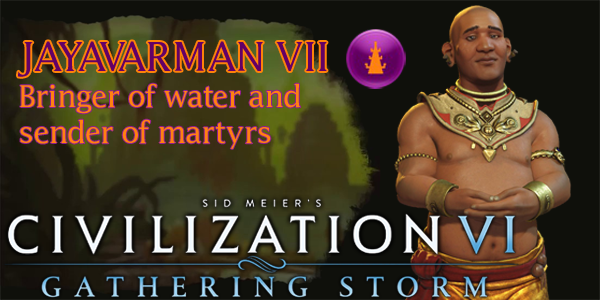
Civilization VI's third expansion, Gathering Storm recently released and has added a handful of new civilizations and leaders. I am hoping to write a strategy for each of them, but I also want to continue to write guides for the civilizations that were already in the game. I put up a poll on my Patreon page for my patrons to vote on which civ(s) they would like to see. The three top vote-getters (from all the three people who voted) were Khmer, Aztec, and Norway. It's been a while since I've done a strategy for a religion-oriented civ, so I thought I'd do a strategy for Jayavarman VII of the Khmer. The Khmer were present as a playable civilization in Civilization IV's Beyond the Sword expansion, but they were not present in Civilization V. They appeared as a DLC civ prior to Rise & Fall's release, but this strategy should work for players of the new Gathering Storm expansion as well.
The city of Angkor, the capital of the Angkor Empire (also called the Khmer Empire), is believed to be the largest pre-industrial urban center in the world, stretching for roughly 400 square miles and housing roughly 0.1% of the entire global population at its zenith. This empire controlled most of mainland southeast Asia from the ninth century CE to the 15th century CE, reaching its zenith between the 11th and 13th centuries. Many impressive ruins still stand in the site of Angkor, and many have been restored by local archaeological organizations and UNESCO, including the impressive Angkor Wat, the largest single religious monument in the world. Satellite imagery has also revealed an intricate network of irrigation channels which were likely used to manage the regions unpredictable monsoons, as well as to support the population.

Around 1150 CE, the kingdom of Angkor was invaded by the neighboring Cham empires, who succeeded at toppling the capital. General Mahaparamasaugata (believed to already be over the age of 60) lead a successful campaign to push the Cham out of the Khmer capital, and he ascended to the throne in order to continue the war and conquer much of the Champa territory. He relocated the capital to Angkor Thom, where large monuments were constructed in his honor, including the temple of Bayon. He went on to re-unify the empire, building a network of roads connecting every major town, complete with rest-houses every 9 miles and hospitals for travelers. He reigned successfully until his death at the impressively-ripe old age 97 or 98, and is regarded as the last great king of Cambodia. He was posthumously re-named Jayavarman VII, after a line of Cambodia's greatest kings.
DISCLAIMER:
Civilization VI is still a "living game". Strategies for the game (and for specific leaders and civs) may change as Firaxis applies balance patches, introduces new features, or expands the game through further DLC or expansion packs, or as the Civ community discovers new strategies or exploits. As such, the following strategy guide may change from time to time. I will try to keep it up-to-date, and will make notations whenever changes are made. I'll also post links in the official 2K forums and CivFanatics, where I'll also report any changes made. If possible and practical, I will try to retain the original content of the strategy for posterity.
I welcome any feedback or suggestions that readers wish to offer. Feel free to post on the linked forums, or by posting a comment at the bottom of the page.
This guide is up to date as of the release of the Gathering Storm expansion (ver. 1.0.0.314) (Antarctic Late Summer Patch, April 2019)
Khmer is a strong religious civ who gets extra food from Holy Sites, and extra faith from Aqueducts, as well as other bonuses to food and amenity. It can build and support large populations in its cities, and gets relics from its missionaries and apostles much more frequently, which can contribute to a culture victory.
... [More]
3a7fbd1d-fdc3-49c8-a0b2-e222656249c4|2|3.5
Tags:Sid Meier's Civilization, Civilization VI, Civilization VI: Gathering Storm, Khmer, Jayavarman VII, Grand Barays, monasteries of the king, domrey, prasat, temple, aqueduct, farm, food, holy site, missionary, apostle, religion, relic, culture, tourism, DLC, Patreon, unique building, unique siege unit
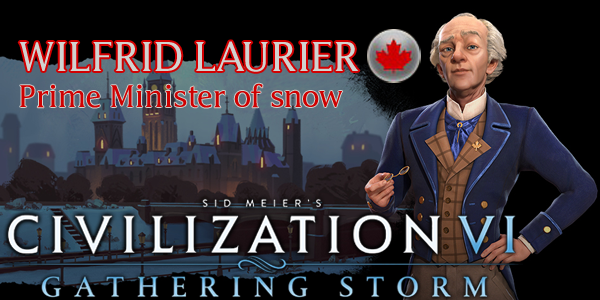
Civilization VI's second expansion, Gathering Storm recently released and has added a handful of new civilizations and leaders. I am hoping to write a strategy for each of them, but I want to start with the civilizations and leaders who are completely new to the franchise.
One of these new civs represents a sort-of "farewell" present to the founder and former lead-host of the PolyCast podcast, Dan Q, who stepped down from the podcast at the end of 2018 in order to spend more time with his new family. However, he'll still be playing Civ, and for the first time in the franchise's history, Dan gets to play as his home and native land of Canada. It's too bad he's not on PolyCast anymore to tell us about how great Wilfrid Laurier of Canada is, eh?

On a more serious note: thank you, Dan for over a decade of faithful service and dedication to the Civilization community. And on a more personal note, thank you for inviting me to join the regular panel on PolyCast. You gave me a voice within this community that I did not think I would ever be able to reach. We'll miss you, Dan, and we hope to talk to you again as a guest host many times in the future. Best wishes to you and your new wife in your new life together. May your lives together be forever in a Golden Age!
This guide is dedicated to you, Dan. Now let's talk about Canada in Civilization VI!
The first European colony in North America is widely accepted to be a Norse encampment in Newfoundland, which was abandoned within a few years of settlement. It wasn't until the 16th century that large-scale colonization began -- mostly by French and British colonists. In 1763, France ceded most of its North American colonies to the British following years of on-again-off-again warfare. The Confederation of Canada was formed over a hundred years later, but remained loyal to the British crown until the Canada Act of 1982. Despite being a formally independent nation, Canada still maintains the British monarch (currently Queen Elizabeth II) as its official head of state. Because many of the founding cities were French colonies, Canada is an officially bilingual country, with both English and French being its official languages, and it is now one of the most multi-cultural nations in the world due to frequent large-scale immigration from other parts of the world. Canadian interactions with indigenous peoples were generally less violent than with neighboring United States' interactions with natives. However, the expansion of Canadian territory still required the forced relocation or assimilation of somewhere between 200,000 and 2 million indigenous peoples, including the Inuit, Métis, the Cree, and several dozen other tribes.
Canada's first French-speaking prime minister was Sir Henri Charles Wilfrid Laurier. Laurier was part of Canada's Liberal party, advocating for decentralized federalism and staunchly defending individual personal liberty. Despite wishing for Canada to remain an autonomous nation loyal to the British Empire, he would go on to oppose British conscription of Canadian citizens in World War I, which would become a polarizing issue in the early 20th century. He gained a reputation as a bright and cheerful leader who always followed the "sunny ways", and has become one of the most beloved prime minsters in Canadian history.
DISCLAIMER:
Civilization VI is still a "living game". Strategies for the game (and for specific leaders and civs) may change as Firaxis applies balance patches, introduces new features, or expands the game through further DLC or expansion packs, or as the Civ community discovers new strategies or exploits. As such, the following strategy guide may change from time to time. I will try to keep it up-to-date, and will make notations whenever changes are made. I'll also post links in the official 2K forums and CivFanatics, where I'll also report any changes made. If possible and practical, I will try to retain the original content of the strategy for posterity.
I welcome any feedback or suggestions that readers wish to offer. Feel free to post on the linked forums, or by posting a comment at the bottom of the page.
This guide is up to date as of the release of the Gathering Storm expansion (ver. 1.0.0.290)
Canda is a prime contender for a turtle strategy, as it cannot surprise declare on other civs, or be surprise declared on. They also specialize in settling in otherwise-inhospitable tundra.
... [More]
504f5955-2cb6-4f67-90d0-584dee7a227e|0|.0
Tags:Sid Meier's Civilization, Civilization VI, Civilization VI: Gathering Storm, Canada, Wilfrid Laurier, four faces of peace, the last best west, tundra, hockey, hockey rink, farm, mountie, national park, tourism, culture, world congress, diplomatic favor, unique improvement, unique mounted unit
|

| 12 | | | | | | | 60 | | 11 | | | | | | | 55 | | 10 | | | | | | | 50 | | 09 | | | | | | | 45 | | 08 | | | | | | | 40 | | 07 | | | | | | | 35 | | 06 | | | | | | | 30 | | 05 | | | | | | | 25 | | 04 | | | | | | | 20 | | 03 | | | | | | | 15 | | 02 | | | | | | | 10 | | 01 | | | | | | | 05 |
|